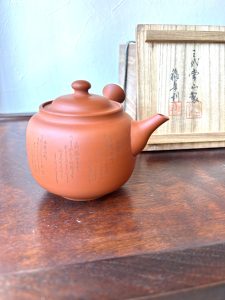使い勝手を優先したデザイン(愛知県名古屋市千種区姫池通 骨董品買取 古美術風光舎)
2024.04.10
みなさまこんにちは。スッタフHでございます。
先日の強風や雨もあり、街を華やかに彩ってくれていた桜も散り始め少し寂しい気もいたします。
このはかなさゆえ毎年の開花を心待ちにしてしまうのかもしれません。
さて先日のブログで煎茶道について綴りましたが、風光舎にも新しく朱泥色の常滑焼の急須が入りました。
三代常山造の急須で、側面には小野小町や在原業平などの歌が刻まれております。小ぶりのサイズで、持ってみるととても軽く、注ぎ口がすっと細く伸びていて、私でも絶対に美味しくお茶を淹れられるはずと思わせてくれる急須です。

急須はあまりにも日常生活に馴染み過ぎて、しみじみと眺めたことはありませんが、この均整のとれた常滑焼を眺めておりますと不思議な感覚になります。実はこの持ち手が横についている茶器は世界的にも珍しいのだそうです。確かに中国の茶壺も、イギリスのティーポットも持ち手が後ろに付いていますね。
急須の起源は諸説あるようですが、江戸時代に中国から伝わってきたとされています。中国の福建省辺りで使用されていた酒や水を温める道具に「急焼(キップシュ)」や同じく酒を温める道具に「急須(キフス)」というものもあり、持ち手が横に付いていました。中国の急須は「急な用に応じて須(もち)いる」という意味を持ち、「三国時代の呉の国の人が酒を温めるために用いた」という文献が残っています。
日本では急焼(きゅうしょう)や急尾焼(きゅうびしょう)などと呼ばれ、最終的に急須(きゅうす)という現代の呼び方になったとのことです。現在でも関東地域や、富山県、石川県、静岡県、三重県、宮崎県など日本全国で急須のことを「きびしょ」と呼んでいる地域があるのだとか。その後庶民の間で「湯沸かし器」から茶を入れる道具に転用されていったそうです。
先日綴った煎茶道を世に広めたとされる売茶翁(ばいさおう)が使った急須はすべて中国産のものでしたが。しかしそれらはとても高価で庶民には手が出なかっため国内でも急須の製造が始まります。日本で初めて急須を作ったとされる清水六兵衛(きよみずろくべえ)は売茶翁の依頼により中国製の物をモデルにした急須を作り、以後日本の急須は独自の発展を遂げていきました。現在中国の茶道で使われている茶壺(ちゃふう)は持ち手が後ろについていますが、当時の日本人はそのまま模倣するのではなく、注ぎやすさを考え、酒器や湯沸かしとして使っていた「急焼」などのように持ち手を横につけることを選びました。また茶こしを内蔵するなど日本人の臨機応変さが際立ちます。

普段何気なく使っている急須ですが先人たちの試行錯誤の末、使い勝手のよい感性されたデザインとして今日まで受け継がれているのですね。
話は変わりますが、先日ふと川沿いを覗き込むと、2匹で仲良くお花見をしている猫たちに遭遇しました。遠くから撮ったので鮮明には写っていませんが、「桜、綺麗だねぇ」と会話しているように見えませんか?とても微笑ましい光景でした。

それでは、また次の機会に。
Hello everyone. This is Staff H.
With the strong winds and rain we had the other day, the cherry blossoms that had decorated the town so beautifully are beginning to fall.
Perhaps it is this transience that makes us look forward to the blooming of the cherry blossoms every year.
As I wrote about the tea ceremony in my blog the other day, we now have a new Tokoname-yaki kyusu (teapot) in reddish brown color at Fuhkosha.
It is made by Tsuneyama III, and the side of the teapot is engraved with poems by Ono no Komachi and Ariwara no Narihira. The kyusu is small in size, very light when you hold it, and has a thin spout that makes you think that even I should be able to brew a nice cup of tea.
I have never looked at a kyusu so intently because it is so familiar to my daily life, but this well-proportioned Tokoname ware gives me a strange sensation. In fact, tea utensils with handles attached to the side are said to be rare in the world. It is true that Chinese tea pots and English teapots have their handles on the back.
There are various theories about the origin of the kyusu, but it is believed to have come from China during the Edo period (1603-1868). There was also a kipshu, a tool used around Fujian Province in China for heating sake and water, and a kyusu, also used for heating sake, both of which had handles attached to the side. In China, kyusu means “to use for urgent purposes,” and there is a document that says “people in the Kingdom of Wu during the Three Kingdoms period used kyusu to warm sake.
In Japan, it was called kyusu-shou or kyubi-shou, and eventually came to be known as kyusu in modern times. Even today, kyusu is still called “kibisho” in the Kanto region and in Toyama, Ishikawa, Shizuoka, Mie, and Miyazaki prefectures throughout Japan. Later, it was converted from a “kettle” to a tool for making tea among the common people.
The kyusu used by Baisao, who is said to have popularized the sencha ceremony, were all made in China, as I wrote about the other day. However, they were very expensive and inaccessible to the common people, so domestic production of kyusu began. Kiyomizu Rokubei, who is said to have been the first to make kyusu in Japan, made a kyusu modeled after a Chinese one at the request of Sacha-o. Since then, kyusu in Japan has developed in a unique way. The tea pot used in the Chinese tea ceremony today has a handle on the back, but the Japanese of the time chose to put the handle on the side for ease of pouring, as in the case of kyushou, which was used as a drinking vessel and for boiling water, rather than imitating the original. The built-in tea strainer also highlights the resourcefulness of the Japanese.
We use kyusu without thinking about it, but after the trial and error of our predecessors, it has been handed down to the present day as a user-friendly and sensible design.
As the story goes, the other day I peeked along the riverside and came across two cats enjoying the cherry blossoms together. The picture was taken from a distance, so it is not clear, but doesn’t it look like they were talking to each other and saying, “Cherry blossoms are so beautiful, aren’t they? It was a very funny scene.
See you next time.
*******************
ご実家の整理やお片付けなどをされている方のご相談などが多くございます。
お片付けなどくれぐれもご無理のないようになさってくださいませ。
風光舎では古美術品や骨董品の他にも絵画や宝石、趣味のお品など様々なジャンルのものを買受しております。
お片付けをされていて、こういうものでもいいのかしらと迷われているものでも、どうぞお気軽にご相談下さいませ。
また風光舎は、出張買取も強化しております。ご近所はもちろん、愛知県内、岐阜県、三重県その他の県へも出張いたします。
まずは、お電話お待ちしております。
愛知県名古屋市千種区姫池通
骨董 買取【古美術 風光舎 名古屋店】
TEL052(734)8444
10:00-18:00 OPEN

